Recent Comments
No comments to show.
Posted by admin in Attachment Parenting, Babies 0-6 months, General, How to, Maternal Health, Pregnancy on May 27th, 2015
When you first fall pregnant, 9 months can seem like FOREVER. All the shopping and appointments and excitement among family and friends is so wonderful and you can’t wait to hold your very own baby in your arms. But before you know it, you have your baby shower or gender reveal party behind you and and just a big belly in the front and wham! your due date is just weeks away. Why not check out our list of 10 things you should get done BEFORE bubs arrives.


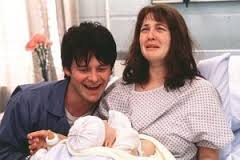
Posted by admin in Attachment Parenting, Babies 0-6 months, General, How to, Pregnancy on May 26th, 2015
Whether you’re hosting a Gender Reveal Party or you just want a cute way to tell family and friends that you are having a baby boy or girl, we’ve got our top 10 gender revealing ideas to help you make the big announcement.

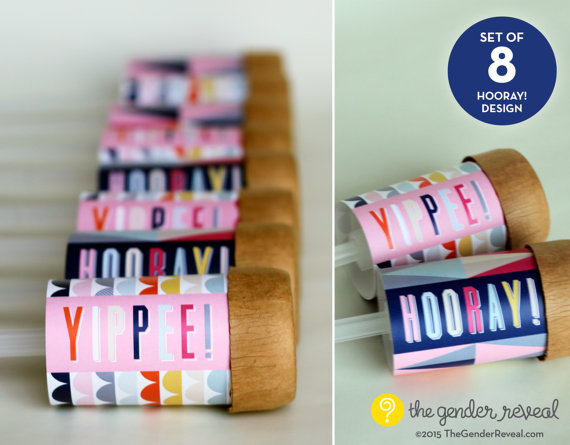
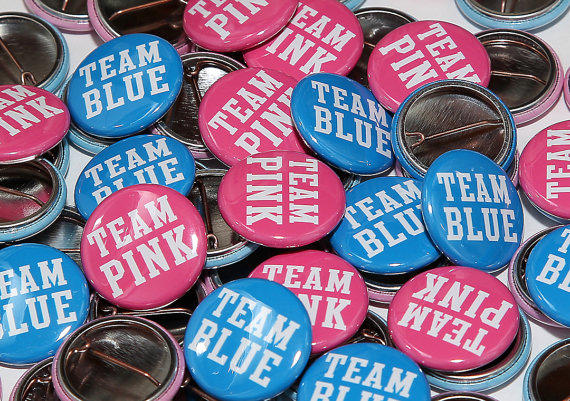
Gender reveal parties are a fun way to include family and friends in the joy and excitement that comes with a new baby. Feel free to share your own gender reveal party ideas below or your pics on our Facebook page.
Posted by admin in Attachment Parenting, Babies 0-6 months on April 23rd, 2015

If you’re fortunate enough to be sitting with a brand new baby nestled on your chest right now, congratulations! There are so many incredible things about newborn babies, including that moment that you actually get to see their little faces for the first time and not just a baby is born, but a mother, a father, grandparents, aunties and uncles…. A whole new family is born on that special day.
Its hard to whittle the list down and keep to just 10 but we’ve listed our 10 favorite things about newbies.
Oh gosh, is there a better smell in the world? Why hasn’t someone bottled it? Their smell makes you fall instantly in love with them.
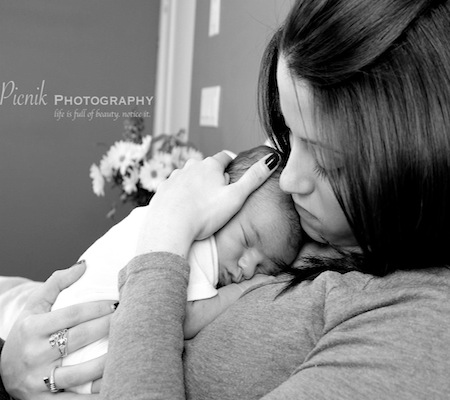
Is it just me or do they look like tiny little perfect seashells?
Yes they’re busy bums who are ah, used a lot, but gee whizz they’re cute as. Often wrinkly, sometimes oddly saggy but always round and kissable. Tiny bums, enough said.
Some babies are born looking like grandbabies – wrinkly like little old people. And those rolls, on their wrists, behind their necks, on their thighs. So hard to resist having a little pinch of that fat!
It doesn’t get much better than having a newborn baby sound asleep on your chest.

I love newborns lips, so perfect and pink and I love that they are born without a single tooth. There’s something so endearing seeing their little gums.
Oh gosh its hard not to go overboard, particularly when they grow so quickly. But oh the little things you can buy, coloured vests, wincy jeans, the tiniest sneakers, silly hats. And baby doesn’t mind at all what they’re wearing. This doesn’t last long – toddlers are a different kettle of fish – so enjoy dressing your baby while you can.

Its just wonderful watching the person you love then falling in love with the person you created together.
I used to love watching my daughter sleeping in her cot, so peaceful with not a worry in the world and her whole life of opportunity awaiting her.
Completely, unconditionally, like no one else has loved you before. You are their entire world and in fact, up till about 6 months of age, babies don’t even understand the concept of individuals. Your baby still thinks he and you are one person! She can remember your voice from when he was in your tummy and she loves the smell of you.
Posted by admin in Attachment Parenting, Babies 0-6 months, Crying, General, Pregnancy, Sleep on April 21st, 2015
For normal, healthy infants crying is a very common occurrence, especially during the first 12 weeks of life. Between 2 and 6 weeks of age a baby’s crying steadily increases and can put a lot of strain on parents, making you feel stress, anxious, angry, upset or just helpless. All babies do go through this period of crying and it can vary in intensity. Much like height or weight, some babies are taller or heavier while others are shorter, some babies cry a great deal, others not so much.
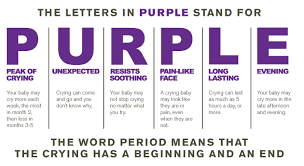
The Period of PURPLE Crying is a concept developed by Dr. Ronald Barr, MCDM, FRCPC, as a way to educate new parents about normal crying behavior and its place in normal child development. The concept of PURPLE Crying is based on almost 50 years of early infant development and crying research by an international cast of scientist and pediatricians. Related studies were done on non-mammalian (breast feeding) species, like chimpanzees, and found that their babies have a similar crying curve. Crying is a normal part of child development.
The acronym PURPLE is used to describe specific characteristics of a baby’s crying during this period. Its important to know that what you are experiencing is quite normal and, although frustrating, is simply a phase in your baby’s development – and it will pass. The word Period is important because it tells parents that it is only temporary and it will come to an end.
When you are feeling frustrated, angry or upset it’s OK to walk away and take a break from the crying. Put your baby in a safe spot (their cot, a rocker or perhaps a pram) and step out of the room, perhaps to a space where you can no longer hear the crying and take a few minutes for yourself, walk around, have a cool glass of water or put the kettle on. The time you spend away from the crying can help you calm down, so you’ll be better able to handle the situation when you come back – even if your baby keeps crying they’ll be fine.
Even when you are at your wits-end, remember its just a phase, crying is normal and you’re doing fine.
Posted by admin in Attachment Parenting, Babies 0-6 months, Pregnancy on April 6th, 2015
Here’s a list (in no particular order) of our top 10 picks to read during your pregnancy.
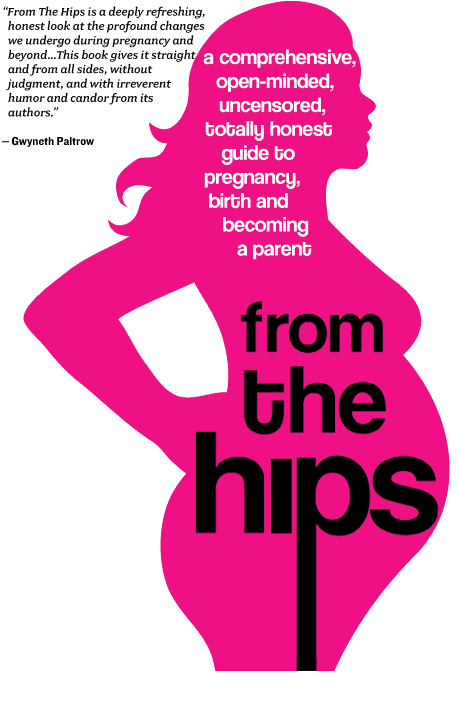
Remember – you can choose to do only some of the things in some of the books, and some of the things in another different book, or you can choose to do none. Its your baby who you will come to know best, books are best to be enjoyed and take from them what you want but don’t expect your baby to have read it. 🙂
Posted by admin in Attachment Parenting, Babies 0-6 months, How to on March 31st, 2015
Making your own chemical free baby wipes is a great way to control what goes on your baby’s skin each day. Homemade wipes are also a great deal cheaper so you can save lots of money, and customize the solution for your baby’s sensitive skin.
There are lots of commercially available products on the market but their ingredients list sound like a science experiment. A sample ingredient list from a popular Australian baby wipes pack reads like this:
Water, Disodium EDTA, Xanthan Gum, Caprylic Triglyceride, PEG 40 Hydrogenated Castor Oil, Benzyl Alcohol, Iodopropynyl Butylcarbamate, Sodium Hydroxymethlyglycinate, Tocopheryl Acetate, Zea Mays (Corn) Oil, Phenoxyethanol, Butylparaben, Ethylparaben, Propylparaben, Isobutylparaben, Fragrance.
Plus they’re expensive. It is however really easy to make your own, either as a spray or solution to use with washable wipes or using paper towel for a more disposable option. All the ingredients are readily available in supermarkets or chemists and once you have your bathroom stocked you should have enough ingredients to make a few batches.

Combine all ingredients, adding water first to avoid creating lots of bubbles. There are many different ways to use and store homemade baby wipes and solution. Choose the method that works best for you:
You can place your reusable cloth wipes in a repurposed baby wipe container or tupperware type storer and pour solution over wipes until moist, but not drenched. (You may have solution left over.)
You can also add the solution you’ve made up to a spray bottle and use as required. Shake well before each use to blend the ingredients each time and then spray your solution straight onto the wipe each time.
You can also spray directly onto your baby but this could be a bit of a surprise for them! Then dry with a dry wipe.
PLEASE NOTE: homemade solutions can go off much quicker than the commercial preparations. Make the wipes or solution in small batches, enough to last a week or two weeks at most.
Posted by admin in Attachment Parenting, Babies 0-6 months, Pregnancy on March 18th, 2015
There’s a lot of product out there in the parenting world and a great deal of it you just. don’t. need. But some things are essential, here’s our list of 10 things you really do need for baby:
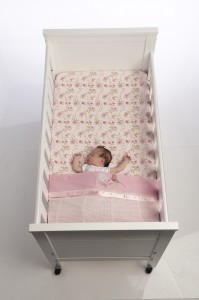
Posted by admin in Attachment Parenting, Babies 0-6 months, Babies 6 months - 4 years, General, Sleep on March 18th, 2015
I remember the disturbed sleep was the hardest part about being a new Mum. I was shocked! What’s this? Broken sleep nearly broke me and I got to the point where I was exhausted. It did end, finally, when my daughter was about 12 months old and the wake ups slowed right down to just once a night and sometimes not at all.
It should be said that broken sleep and babies waking regularly during the night is completely normal.
You haven’t done anything wrong, and neither has your baby. Its normal.
It might help you to know that “sleeping through” means 5 hours of straight sleep, not 8 or 10 (sorry!).
For many parents and caregivers, even if you don’t have to get up to go to work in the morning, the question you will ask yourself more than any other may well be will this baby ever sleep through the night?
The answer is yes – sort of. The truth is, few babies truly ‘sleep through the night’ in the same way an adult does. In fact, sleep researchers have found that little people under 12 months old will normally wake up an average of three times during the night. For the first few months of life, 95% of babies will cry when they wake up and they’ll mostly want some help from you getting back to sleep. But eventually, they’ll learn to just nod back off to sleep on their own.

Several studies have found that by eight months old, over 50% of infants who wake at night go back to sleep without any attention from parents or other caregivers. In fact, sometimes their parents didn’t even realise they’d been awake.
All babies are individuals, and sleep patterns vary greatly from child to child. Even though typical sleep patterns don’t apply to all babies, researchers have identified general patterns that you can look for as your child gets older.
Sleep for newborn to six months
It might seem hard to believe when you don’t get enough sleep yourself, but wee babies sleep around 18 hours a day. It’s also ok if yours sleeps more than that, or less than that. Generally speaking little babies will sleep in batches of a few hours at a time, between 2 and 4 then wake for short periods (quick feed, change, cuddle and back off to sleep). The pattern may vary and change somewhat, and it does go on around the clock. A newborn doesn’t know that people sleep when it’s dark, and a baby’s ‘circadian rhythm’ – the 24-hour internal clock that controls our sleeping and waking patterns – is still developing.

By around six months of age, babies may have their big sleep at night and have some pattern with darkness and light. At six months, your baby will probably still wake a few times a night, and that’s ok.
Researchers using video recording in nurseries found that babies vary a lot when it comes to waking and crying – or not crying – at night. They found the biggest changes in infants’ sleeping and waking patterns happen between three and six months. Six-month-olds sleep longer at a stretch than three-month-olds. They’re also more likely to go back to sleep on their own when they wake.
There are so many wonderful changes in babies during the first 12 months. Sleep is one of them, as babies develop more adult-like sleep patterns, so hang in there. Sleep is on the way.
If you’ve never had a period of bad sleeping before, you might get a shock at just how much lack of sleep can affect your life. It’s important you still look after yourself during this time, and try to get the sleep you need to feel rested. So leave the housework, rest when your baby does, catch a lie down together when you feed and accept all offers of help from friends and family.
baby sleep, baby sleeping through the night, how to get baby to sleep, normal baby sleep, sleeping through
Posted by admin in Attachment Parenting, Babies 0-6 months, General, How to on March 18th, 2015
Just like us, babies are people too and individual people so sadly there’s no one size fits all method of helping babies get to sleep. It may help you feel a little better to know that “sleeping through the night” in baby terms means 5 hours straight. If that’s not happening for you and you’re feeling exhausted and sleep deprived, there are some gentle strategies you can try to help your baby get to sleep and sleep longer.

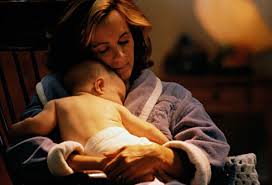
Hopefully one or a combination of these tips will help you get your baby off to sleepyland. G’night.
Posted by admin in Attachment Parenting, Babies 0-6 months, General, How to, Safety on February 24th, 2014
The practice of co-sleeping is becoming more and more prevalent in Western countries. Recent research conducted in the USA and Australia revealed that:
Despite the rise in bed-sharing, the practice has its detractors. Here are some of the pros and cons, to help you make up your own mind.
Advocates of co-sleeping argue that it is natural and beneficial for baby, makes bubba feel safe and secure, builds a greater bond between parent and child, and makes it easier to breastfeed and settle baby during the night. Many parents who sleep with their baby report a greater sense of ease, knowing their child is always close. In addition, many advocates of bed-sharing believe that co-sleeping infants cry less during the night.
A number of health bodies, including the highly respected SIDS and Kids, argue that sleeping with baby actually increases the risk of Sudden Infant Death Syndrome (SIDS) and fatal sleep accidents.
Instead of bed-sharing, SIDS and Kids recommends sleeping a baby in a cot next to the parents’ bed for the first six to twelve months. Nevertheless, the jury is out and there are conflicting opinions about the dangers of co-sleeping, with some doctors pointing out that cultures that traditionally practice safe co-sleeping enjoy the lowest incidence of SIDS.
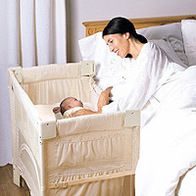
Arms Reach Cosleeper
Still unsure? There is an alternative.
The decision to co-sleep is a highly personal one. Ask questions, do your research and, if you’re still unsure, you might prefer to walk the middle ground, and buy or hire a special bassinet, known as a co-sleeper, that attaches securely to the side of your bed. Baby will still be close to hand but he or she will also be on a separate sleeping surface.
arms reach cosleeper, bednest, co-sleeping, cosleep, how to cosleep, SIDS, sleeping with baby
